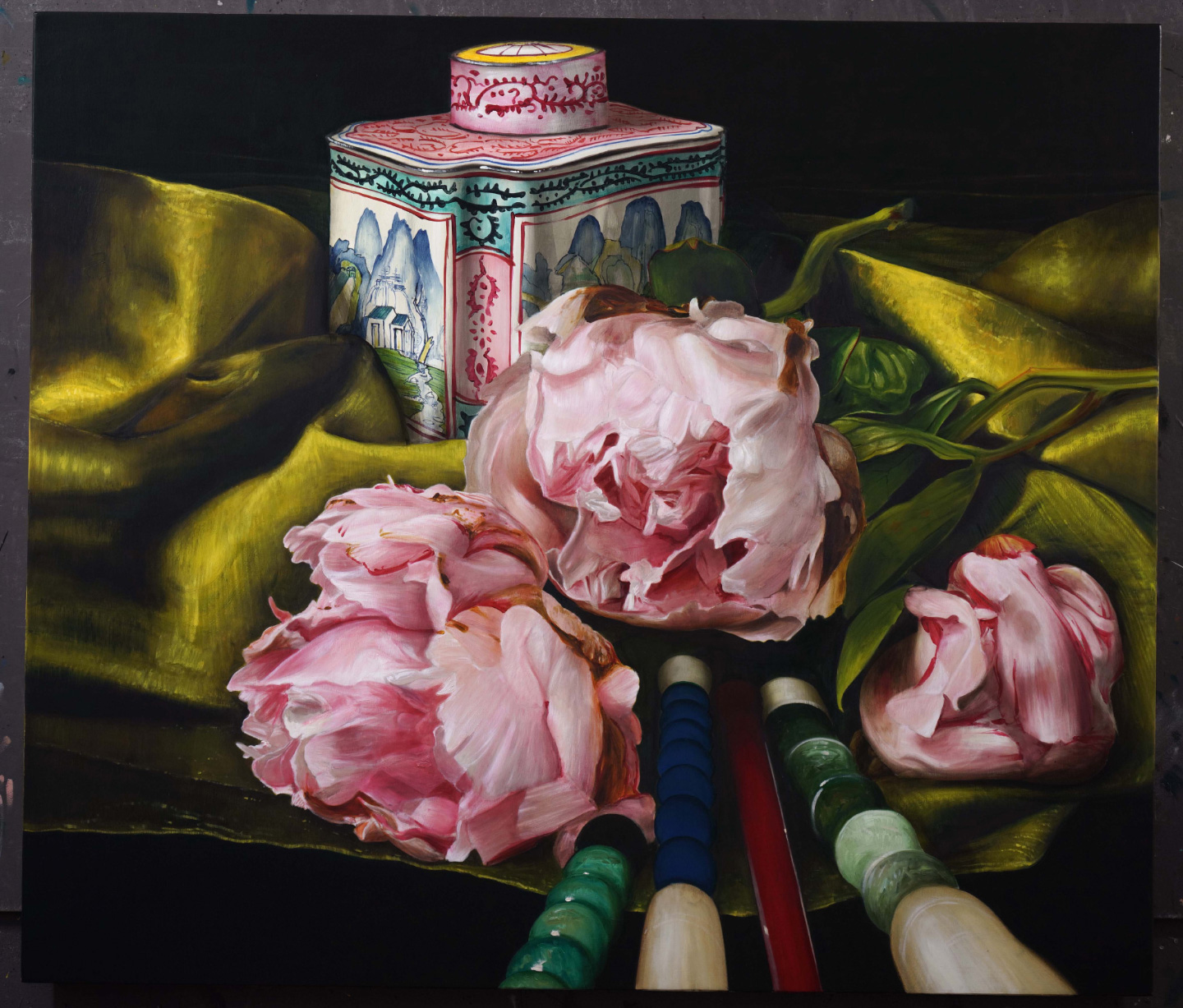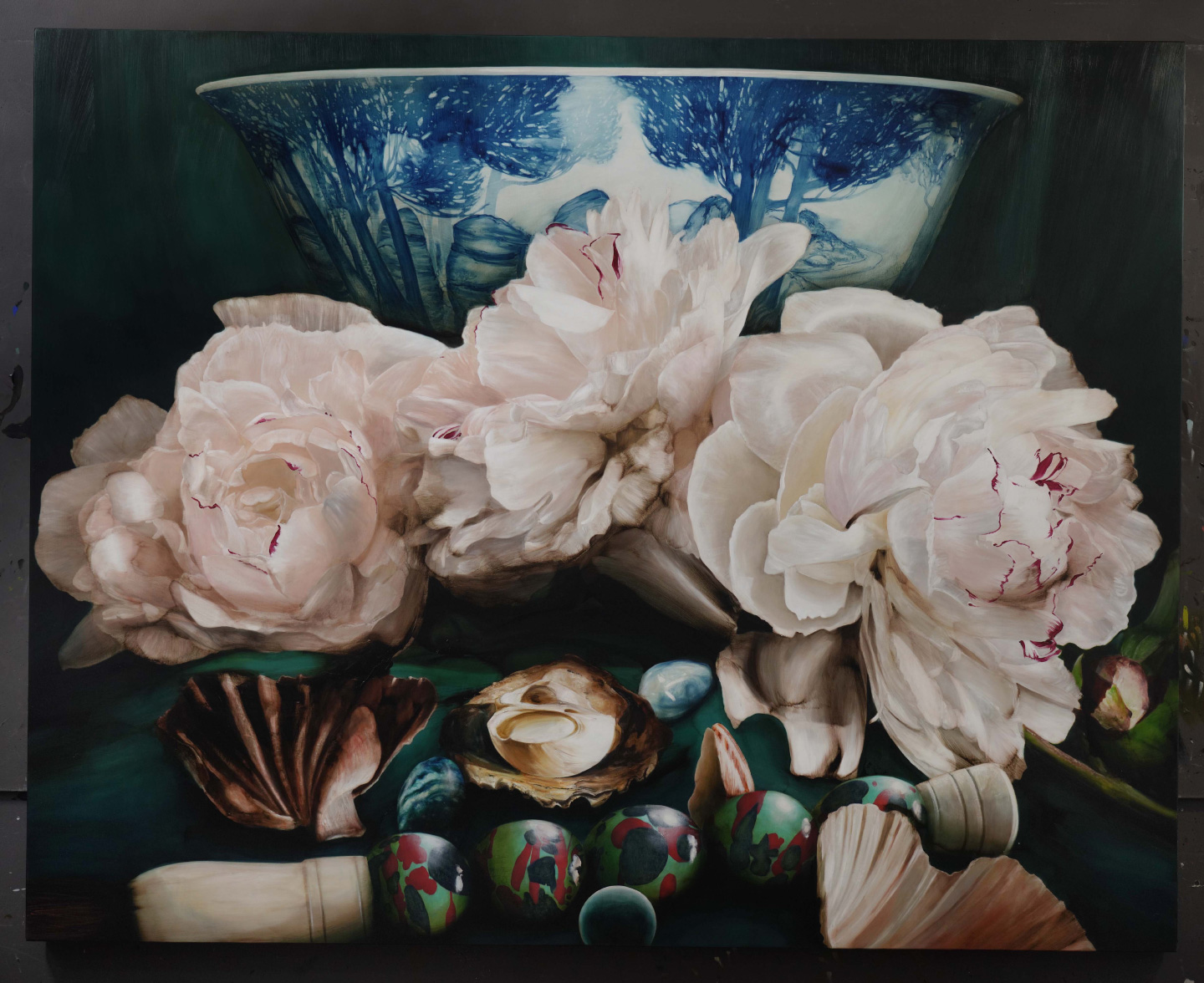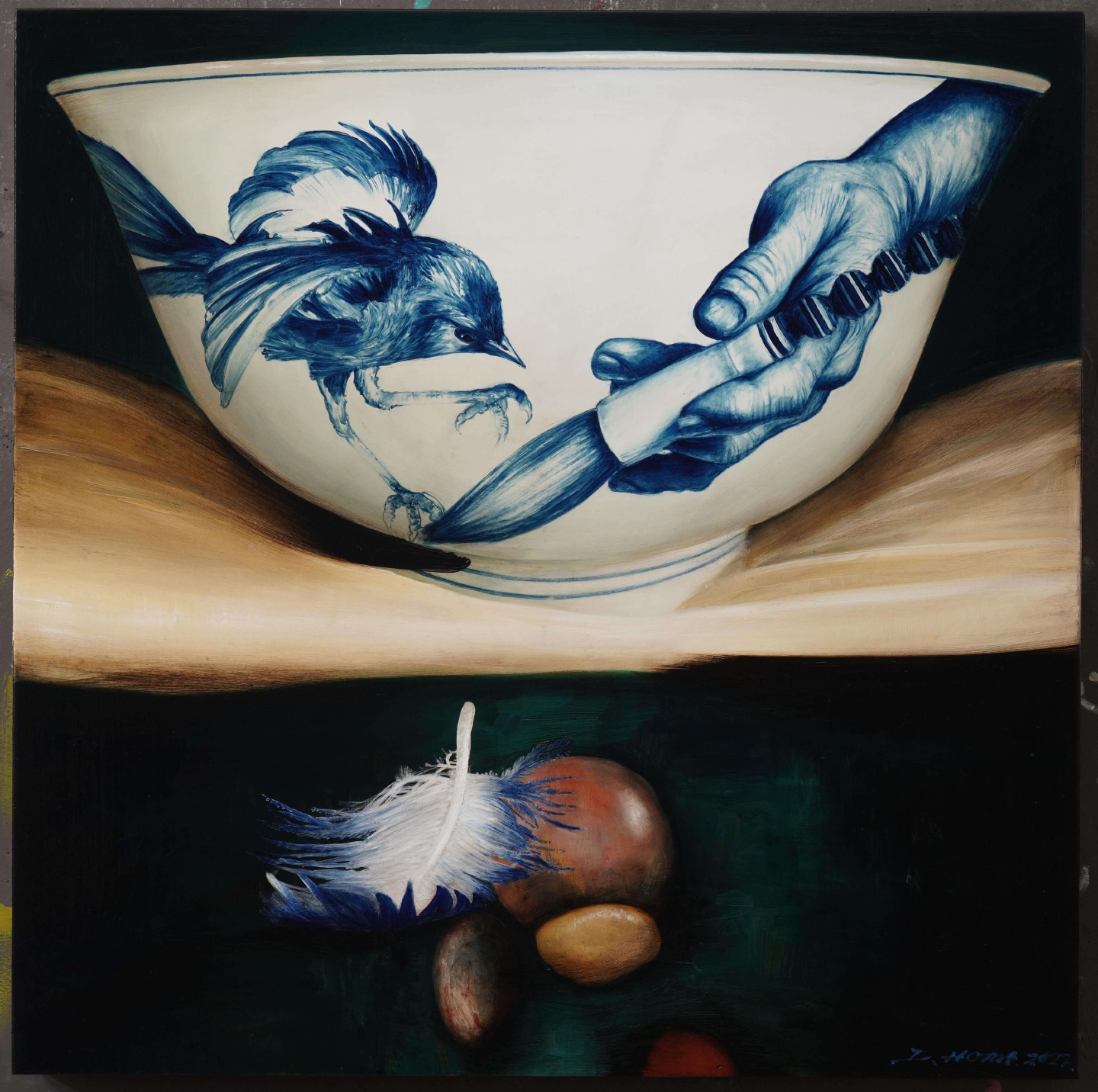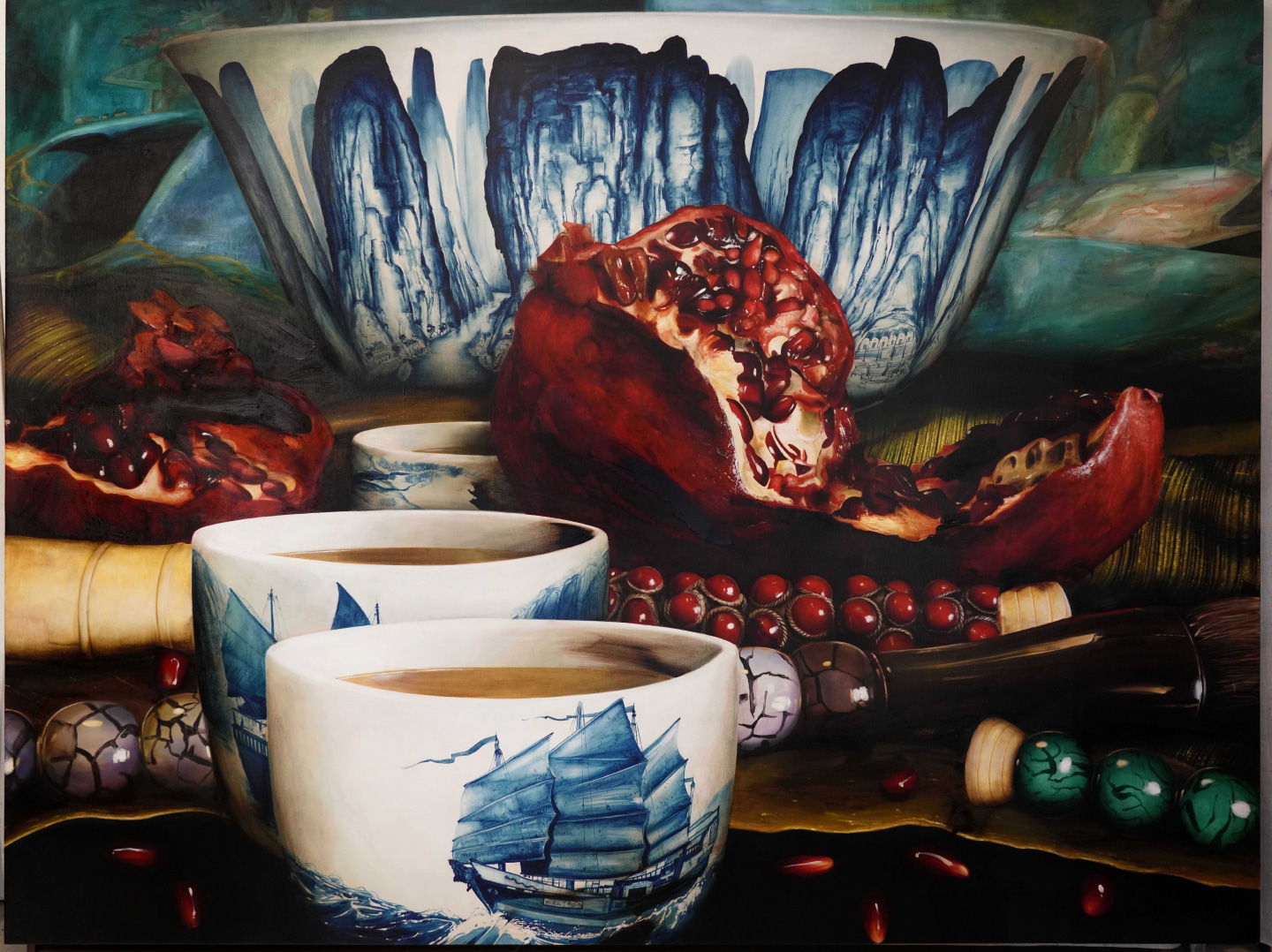The still life can be the embodiment of values, tastes and time. It has the ability to appeal to the primary instincts of human nature, of food and substance. Australian artist Dean Home’s striking works in this genre are not only symphonies in composition, they are invitations to meditate on beauty, mortality and truth.
Dean Home has, in his almost 40-year artistic career, brought a deep intensity and drama to the still life works for which he is widely recognised. Over the last two decades in particular, he has come to be known for his sensual and sumptuous renderings of ripe to bursting fruits set within fascinating scenes that recall the exotic fables and landscapes of the Orient. His compositions can be translated as meditations on beauty and time, and bear the influence of the depth of wisdom of ancient Chinese poetry.
Born in Busselton, Western Australia in 1961 to parents who both had interests in art, Home started doing simple pencil drawings of stick figures at the age of four. With his parents’ encouragement, following high school, he left the countryside of his upbringing in 1979 to attend Curtin University in Perth where he obtained a Bachelor of Arts Degree.
Following an extensive period when Home focused on predominantly figurative painting, which culminated in 2004 when he was commissioned by the National Portrait Gallery to paint Sir Gus Nossal AC, distinguished scientist and Australian of the Year 2001, the artist changed paths to pursue still life, one that he has not deviated from since.

Home has since emerged as one of Australia’s best-selling contemporary artists. His earlier still life paintings had something of a classic European feel and whilst they were both admired and acquired, they somehow were not fully at ease within contemporary Australian art market. The artist’s talent was never in question, nor was his enthusiasm to reach a certain level of perfection, and as the years passed, the introduction of a number of collected Asian artifacts into his world provided the catalyst for a dynamic change. “I picked up some Chinese porcelain bowls at auction, including one from the Kangxi period (1662-1722),” Home reveals. “They had a strong sense of landscape and finding them was something that totally unleashed my imagination.”
This change, coupled with his imaginative storytelling ability, took Home’s work to another level. The fruit took on vibrant new hues and the ceramic pieces different perspectives on life. “I have this sort of telescopic effect in terms of setting up the still life and finding the actual objects that go into them; I have to be fascinated with them,” he says. “There are so many elements involved - different pieces of blue and white, fabrics and the way the light falls on the characters. It’s not about just choosing any object and painting it, that’s simply not enough. The composition must resonate with me before I start a piece and every time I work, I get deeper and deeper into the process.”


Home’s sumptuous paintings, some of which measure up to 2 by 1.2 metres, are a rich and colourful assault on the senses. Each work tells a different tale in order to create diversity within a cohesive body of work. “I try to reach into my mind and think where things came from. The Asian idea of continuity and maintenance and renewal of ideas is very interesting to me,” says Home. “I understand the metaphors to an extent that some people actually think I’m Chinese.”
In early 2019 Home and his wife Aileen travelled to Italy and France exploring new towns and revisiting some “old friends” unaware, like all of us, that something would soon rear up and dominate world events for three years. “In the turmoil then and now, I found myself in a fortunate position where the galleries that represent me pushed their boundaries and received a strong response from people who were predominantly at home, their lives inside their houses,” notes the artist. “Undoubtedly everyone has a story to tell about how they dealt with those difficult times - for me it coincided with developing the discoveries from the European trip.”
The discovery in Rome of the frequently mentioned but not before seen peonies on the roadside near the Mercato Trionfale was quite a surprise according to Home, but it ignited a love affair that resulted in his wildly successful 2020 exhibition ‘Flowing Fragrance: Dwelling in the Green Mountains’ at Sydney’s Arthouse Gallery, followed by 2021’s ‘Journeys Through The Peony Garden’ at Queensland’s Gallery One.
“They were an explosion of colour and panache. We piled on the train back to our accommodation at Villa Ruffo with an armload of flowers, everyone viewing me as a likely hopeless romantic. The following photographic sessions with those flowers was very intense: I was not in my studio, I did not have the camera I would normally use and I had no access to the things I so often include in my paintings,” notes the photographer in his catalogue introduction to the exhibition. “The colours of these flowers, pure and intense, were vivid and saturated while the fragile delicacy of the petals was so revealing of moods and swings of temperament that I had not yet felt or projected. This was my first revelation. I still use many of those images to develop my ideas and compose new works and I have found different styles of peonies in Australia to add to my resources - it is a work in progress.”


Home’s latest work is a large-scale painting that hangs in Canton Blue, the Chinese fine dining restaurant at the soon-to-be-opened Peninsula London.
The space’s décor, created by Hong Kong interior designer Henry Leung of CAP Atelier, is inspired by the Keying junk, a three-masted, 800-ton Chinese trading ship which sailed between China and Britain between 1846 and 1848, and the vessel is featured on two teacups that sit in the foreground of Home’s work which also carries his familiar porcelain bowl, assorted calligraphy brushes and ripe crimson pomegranates
“When Mark Jason asked me to plan up and quote such a project there wasn’t much that was at all familiar about it. I had no experience with dealing with the UK: VAT, international art transport and even what I was going to paint the work on were new territory for me. This would be the first canvas surface I had painted on for some 30 years as I always paint on board surfaces that I build myself,” says Home.
Home was asked for the work to reference trade from the East and to the West as the broad underlying theme. “I wanted to draw people into the picture and impart the sense of a journey from the interior, down the river to trading ports and out into the world. While it was clearly going to be my style, the brief for the commission suggested including references to Asian maritime trade, so I developed the image with that in mind,” adds the artist.
Home built a frame in his studio and stretched the biggest canvas he could find on it. The character of the canvas, despite being primed seven times left a texture that seemed to soften all his details. “Still we got past these things and I was happy that I could get the picture to go beyond an assembly of details and themes to have some real presence and drama about it – a little bit of fire in it. A bit later I found it near impossible to source an image of a junk from the front coming toward you – so there was lots of drawing and imagining!”
The work developed over a couple of months, as there are many layers in Home’s painting. “Then transporting, restretching and framing bought it back to life in the U.K. and I just had to be patient until its installation. I was thrilled when Mark finally told me it was destined for The Peninsula London.”
